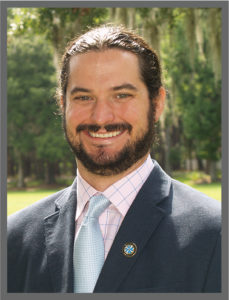We explore the chemistry of elements which are present in seawater at extraordinarily minute concentrations. Termed “trace elements,” they are present in ocean water at concentrations of parts per billion or parts per trillion. Despite these tiny amounts, trace elements can control the distribution of life in the surface ocean.
Phytoplankton, microscopic plant-like organisms that use sunlight for photosynthesis, are the basis of the marine food chain. In addition to sunlight and macronutrients like nitrate and silicate, phytoplankton metabolism requires trace elements to function properly. Thus, primary production can be limited by trace elements in vast areas of the ocean because their small concentrations are unable to meet the biological demand.
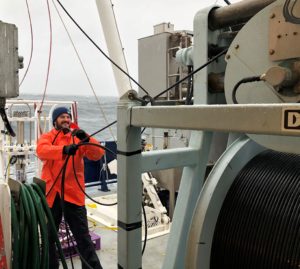
Dr. Buck handling cable on the deck (Credit – A. Fox)
We ask fundamental questions about marine trace element chemistry. What are the sources and sinks of trace elements? What are the input and removal rates? We collect samples from around the world and characterize the chemistry of seawater, precipitation, groundwater, marine particles, and aerosol particles.
Lab Members
Our group and department values the contributions of all and endeavors to foster an inclusive environment. Learn more about Diversity and Inclusion initiatives here: https://www.marsci.uga.edu/diversity-inclusivity
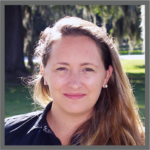
Charlotte Kollman came to SkIO as a new PhD student in Fall 2020. She is working on the Hawaii Aerosol Time Series project and has completed six cruises to HOT Station Aloha.
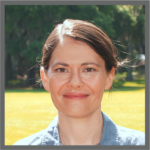
Dr. Althea Moore joined our team in May 2021. A marine ecologist by training, she is working on our project studying the impacts of terrestrial epiphytes on rainfall chemistry. She recently led the writing of a our first paper from this project.
Lab Alumni
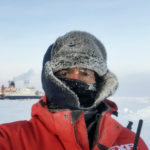
Dr. Marsay with Polarstern in the background.
Dr. Chris Marsay is now a researcher at the University of Delaware. Our work with the US GEOTRACES program took him to the North Pole in Fall 2015. Thus far, he has led two papers describing Arctic aerosols and melt ponds.
In 2018, he completed the second leg of the GEOTRACES GP15 section from Hawaii to Tahiti and has published two papers from this project.
He returned to the Arctic in early 2020 as part of the MOSAiC expedition studying the impacts of climate change.
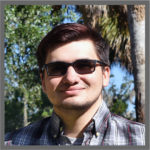
Devon Umstead joined the group in Fall 2019 as a Master’s student and completed his degree in May 2022. His thesis work reported data from North Pacific aerosol samples collected during GEOTRACES GP15. He explored the relationship between aerosol fractional solubility and the presence of acidic compounds in the atmosphere.
Current Research Projects
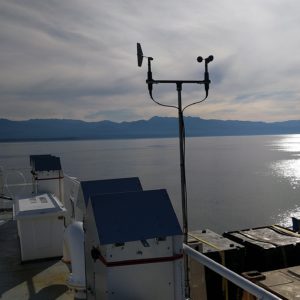
Aerosol samplers aboard ship.
Dr. Buck is the principal investigator of the National Science Foundation funded project US GEOTRACES PMT: Quantification of Atmospheric Deposition and Trace Element Fractional Solubility. The 2018 U.S. GEOTRACES Pacific Meridional Transect (GP15) crossed the North Pacific basin from the dusty northern hemisphere to the pristine and oligotrophic south. Quantifying the atmospheric fluxes of trace elements to the ocean is an essential component of the GEOTRACES mission and no study in this region has combined atmospheric sample collections with multi-element, high-resolution sampling of the upper ocean. We will also be conducting dissolution experiments to explore the mechanisms which control aerosol solubility and bioavailability.
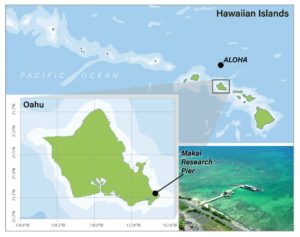
Aerosols will be collected at the Makai Research Pier on Oahu.
The Hawaii Aerosol Time-Series (HATS) is a four-year project designed to link changes in aerosol chemistry and deposition with marine particle chemistry in the upper ocean. Our plan includes two years of aerosol sampling at the Makai Research Pier and cruises to Station Aloha to collect particle samples from the water column. The cruises will run in conjunction with the Hawaii Ocean Time-Series program.
This research is supported by NSF award 1949660.
We discussed the project in this profile: Aerosol Dust and Ocean Chemistry
We also work on land. NSF has supported our study (1954322) of changes to solute chemistry as rainfall travels through tree canopies. We are working with partners at Cleveland State University and University of Kentucky. Dr. Moore is leading the field work and chemical analyses associated with this project.
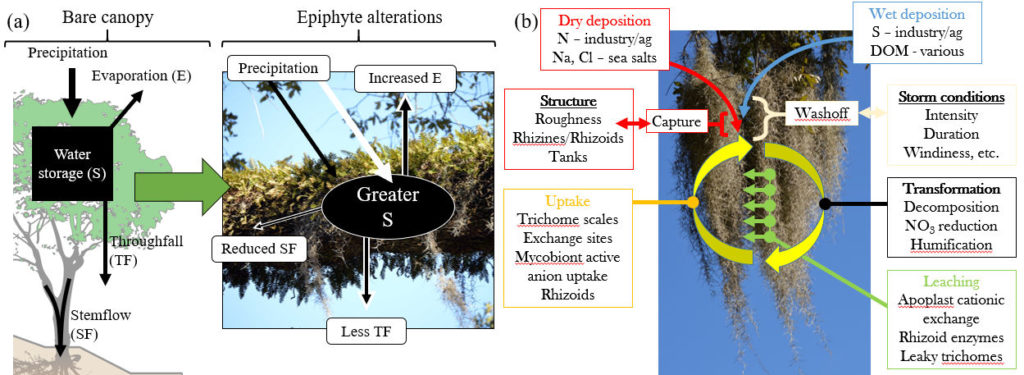
Canopy water and solute alterations during rain. (Credit – J. Van Stan)
Past Research Projects
 The National Science Foundation has also funded our participation in the The Multidisciplinary drifting Observatory for the Study of Arctic Climate (MOSAiC) project. Dr. Marsay joined a group of scientists from around the world aboard the RV Polarstern collecting samples of atmospheric deposition to better understand this important transport pathway in the planet’s most rapidly changing environment. The ship spent 2020 frozen in the Arctic sea ice and serving as a floating observatory.
The National Science Foundation has also funded our participation in the The Multidisciplinary drifting Observatory for the Study of Arctic Climate (MOSAiC) project. Dr. Marsay joined a group of scientists from around the world aboard the RV Polarstern collecting samples of atmospheric deposition to better understand this important transport pathway in the planet’s most rapidly changing environment. The ship spent 2020 frozen in the Arctic sea ice and serving as a floating observatory.
Read more about Dr. Marsay’s experiences in the ice:
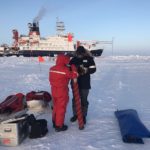
Dr. Marsay preparing to collect ice core samples.
Preparing for a trip to the Arctic
It’s Cold Up Here
COVID-19 Impacts trip to the Arctic
Headed for Land
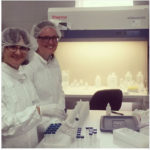
Dr. Falco (Spain) and Ms. Rocha (Brazil) prepare groundwater samples for analysis.
We welcomes collaborators from around the world who wish to take advantage of our resources. In 2017, we welcomed Dr. Sylvia Falco from Valencia, Spain. Dr. Falco specializes in coastal and estuarine water quality issues. We also hosted two graduate students from Rio Grande, Brazil. Ms. Cacinele Rocha and Ms. Mariele Paiva have spent several months learning techniques for collecting and analyzing environmental samples for trace elements. The data they have produced will be incorporated into their respective theses.
We have a long running collaboration with the international GEOTRACES program which is a study of the biogeochemical cycles of trace elements and their isotopes. GEOTRACES has greatly increased the number of trace element observations from around the world and data is viewable at the eGEOTRACES electronic atlas. The Buck Lab has participated in three research cruises, US GEOTRACES GP16, GN01, and GP15 which were supported by the National Science Foundation.
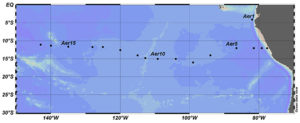
Sample locations for the US GEOTRACES GP-16 cruise track from Ecuador to Tahiti.
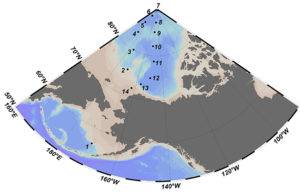
Sample locations for the US GEOTRACES GN-01 cruise in the Arctic Ocean.
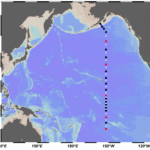
Station locations for the US GEOTRACES GP15 cruise completed in 2018.



